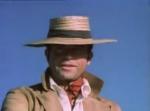

Set in the late 1800s, Robbery Under Arms is the story of bushranger Captain Starlight, told from the perspective of young Dick Marsden. Dick and his brother Jim follow their father's footsteps, on the wrong side of the law. After they succumb to the impetuosity of a tossed coin and participate in the theft and subsequent sale of fifteen hundred head of cattle, the pair team up with the mysterious Starlight (the renegade son of a British noble family), and evolve from petty criminals to outlawed bushrangers, terrorising the countryside, often in partnership with their father Ben and Starlight's Aboriginal offsider Warrigal. Throughout this story, the brothers find themselves at odds with both their mother and sister and with the lives they could have otherwise led.
In taking his narrative perspective from one of the outlaws, Boldrewood exposes the emotions and actions of the Marsden brothers and Captain Starlight in a way that humanises their plight. even while they move from petty thieves to dangerous fugitives. Conversely, by limiting the narrative role of the police, and particularly Inspector Morringer, Boldrewood assigns the law-abiding characters the roles usually reserved for criminals.
Note on production:
The production of Robbery Under Arms was unusually complicated. In light of the expenses involved in the production, a film (two and a half hours) and a mini-series (six one-hour episodes) were filmed simultaneously.
Some sources suggest that the film was a cut-down version of the mini-series (as, for example, with the Escape from Jupiter television series, which was cut down to film length for video release).
Other sources suggest that two completely different scripts were prepared, one for the mini-series and one for the film.
Director Donald Crombie specified that it was something of a combination of both: according to Crombie, the film was created by cutting down segments of the miniseries and 'putting in the least amount of story. [We then edged] material back in until we were absolutely sure that it was the best story [we could tell] in the shortest time' (ctd. Sheila Johnston and Neil Roddick Cinema Papers May 1985, p. 58).
The production also used two directors, but both are credited on both film and mini-series.
Mini-series and film have been treated as separate works, but have a complicated relationship to one another.
 'Robbery Under Arms'
Perth
:
Centre for Research in Culture and Communication (Murdoch University)
,
2003
Z1609358
2003
single work
criticism
'Robbery Under Arms'
Perth
:
Centre for Research in Culture and Communication (Murdoch University)
,
2003
Z1609358
2003
single work
criticism
Research undertaken by a student of the Centre for Culture and Communication (Murdoch University) into the 1985 combined film and television adaptation of Robbery Under Arms. Includes aspects relating to the production phase, critical reception, principal performers and production crew, references and a synopsis.
 'Robbery Under Arms'
Perth
:
Centre for Research in Culture and Communication (Murdoch University)
,
2003
Z1609358
2003
single work
criticism
'Robbery Under Arms'
Perth
:
Centre for Research in Culture and Communication (Murdoch University)
,
2003
Z1609358
2003
single work
criticism
Research undertaken by a student of the Centre for Culture and Communication (Murdoch University) into the 1985 combined film and television adaptation of Robbery Under Arms. Includes aspects relating to the production phase, critical reception, principal performers and production crew, references and a synopsis.